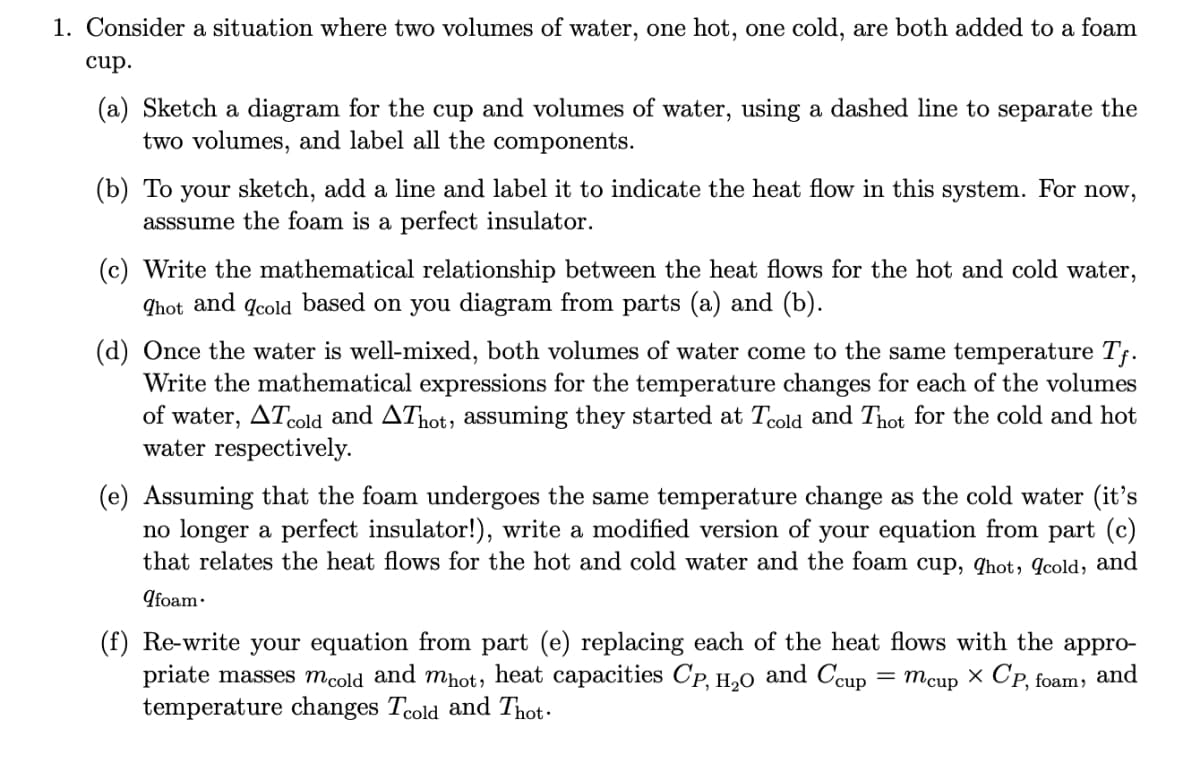1. Consider a situation where two volumes of water, one hot, one cold, are both added to a foam cup. (a) Sketch a diagram for the cup and volumes of water, using a dashed line to separate the two volumes, and label all the components. (b) To your sketch, add a line and label it to indicate the heat flow in this system. For now, asssume the foam is a perfect insulator. (c) Write the mathematical relationship between the heat flows for the hot and cold water, ghot and cold based on you diagram from parts (a) and (b). (d) Once the water is well-mixed, both volumes of water come to the same temperature Tƒ. Write the mathematical expressions for the temperature changes for each of the volumes of water, ATcold and AThot, assuming they started at Tcold and Thot for the cold and hot water respectively. (e) Assuming that the foam undergoes the same temperature change as the cold water (it's no longer a perfect insulator!), write a modified version of your equation from part (c) that relates the heat flows for the hot and cold water and the foam cup, hot, cold, and qfoam. (f) Re-write your equation from part (e) replacing each of the heat flows with the appro- priate masses mcold and mhot, heat capacities CP, H₂O and Ccup = mcup x CP, foam, and temperature changes Tcold and Thot.
1. Consider a situation where two volumes of water, one hot, one cold, are both added to a foam cup. (a) Sketch a diagram for the cup and volumes of water, using a dashed line to separate the two volumes, and label all the components. (b) To your sketch, add a line and label it to indicate the heat flow in this system. For now, asssume the foam is a perfect insulator. (c) Write the mathematical relationship between the heat flows for the hot and cold water, ghot and cold based on you diagram from parts (a) and (b). (d) Once the water is well-mixed, both volumes of water come to the same temperature Tƒ. Write the mathematical expressions for the temperature changes for each of the volumes of water, ATcold and AThot, assuming they started at Tcold and Thot for the cold and hot water respectively. (e) Assuming that the foam undergoes the same temperature change as the cold water (it's no longer a perfect insulator!), write a modified version of your equation from part (c) that relates the heat flows for the hot and cold water and the foam cup, hot, cold, and qfoam. (f) Re-write your equation from part (e) replacing each of the heat flows with the appro- priate masses mcold and mhot, heat capacities CP, H₂O and Ccup = mcup x CP, foam, and temperature changes Tcold and Thot.
Principles of Heat Transfer (Activate Learning with these NEW titles from Engineering!)
8th Edition
ISBN:9781305387102
Author:Kreith, Frank; Manglik, Raj M.
Publisher:Kreith, Frank; Manglik, Raj M.
Chapter9: Heat Transfer With Phase Change
Section: Chapter Questions
Problem 9.26P
Related questions
Question

Transcribed Image Text:1. Consider a situation where two volumes of water, one hot, one cold, are both added to a foam
cup.
(a) Sketch a diagram for the cup and volumes of water, using a dashed line to separate the
two volumes, and label all the components.
(b) To your sketch, add a line and label it to indicate the heat flow in this system. For now,
asssume the foam is a perfect insulator.
(c) Write the mathematical relationship between the heat flows for the hot and cold water,
hot and cold based on you diagram from parts (a) and (b).
(d) Once the water is well-mixed, both volumes of water come to the same temperature Tf.
Write the mathematical expressions for the temperature changes for each of the volumes
of water, ATcold and AThot, assuming they started at Tcold and Thot for the cold and hot
water respectively.
(e) Assuming that the foam undergoes the same temperature change as the cold water (it's
no longer a perfect insulator!), write a modified version of your equation from part (c)
that relates the heat flows for the hot and cold water and the foam cup, qhot, qcold, and
qfoam.
(f) Re-write your equation from part (e) replacing each of the heat flows with the appro-
priate masses mcold and mhot, heat capacities CP, H₂O and Ccup = mcup x CP, foam, and
temperature changes Tcold and Thot.
Expert Solution
This question has been solved!
Explore an expertly crafted, step-by-step solution for a thorough understanding of key concepts.
This is a popular solution!
Trending now
This is a popular solution!
Step by step
Solved in 2 steps with 3 images

Knowledge Booster
Learn more about
Need a deep-dive on the concept behind this application? Look no further. Learn more about this topic, mechanical-engineering and related others by exploring similar questions and additional content below.Recommended textbooks for you

Principles of Heat Transfer (Activate Learning wi…
Mechanical Engineering
ISBN:
9781305387102
Author:
Kreith, Frank; Manglik, Raj M.
Publisher:
Cengage Learning

Principles of Heat Transfer (Activate Learning wi…
Mechanical Engineering
ISBN:
9781305387102
Author:
Kreith, Frank; Manglik, Raj M.
Publisher:
Cengage Learning